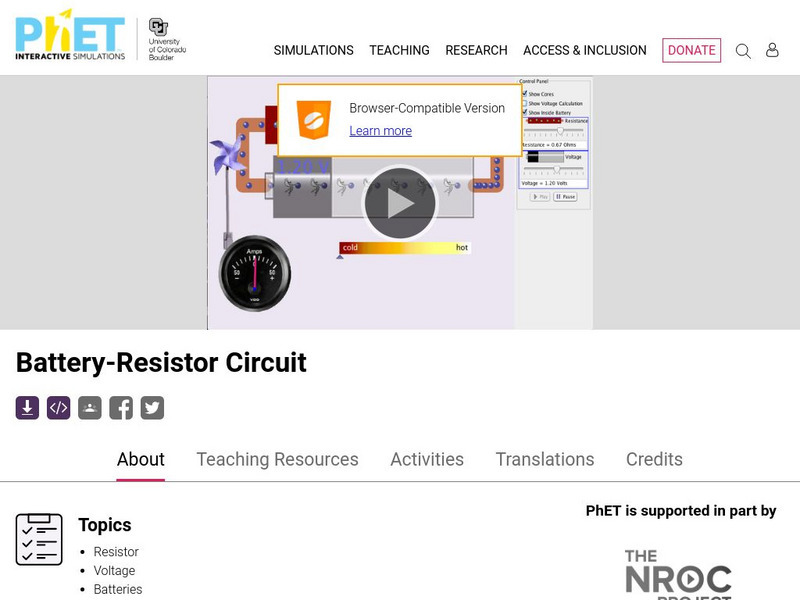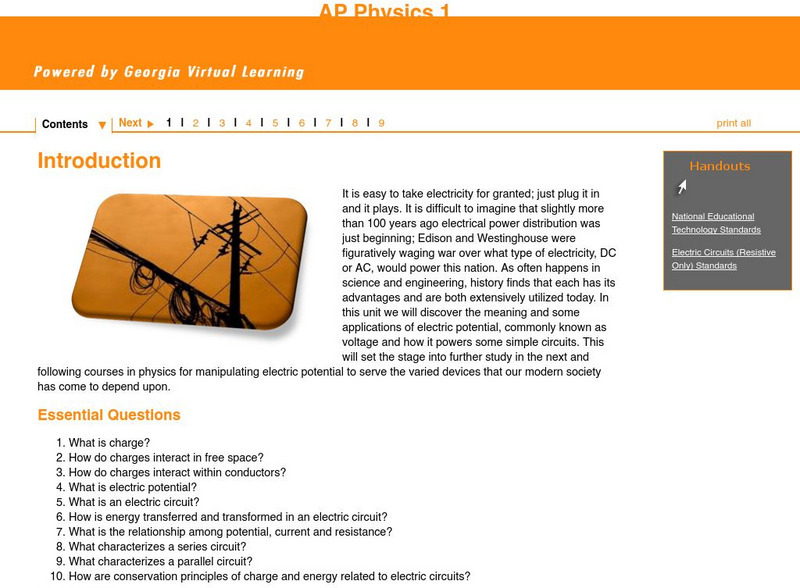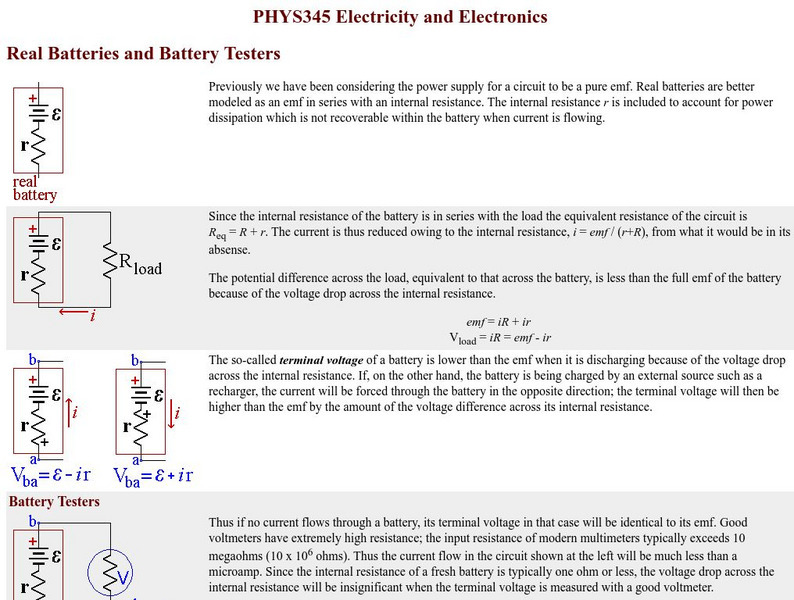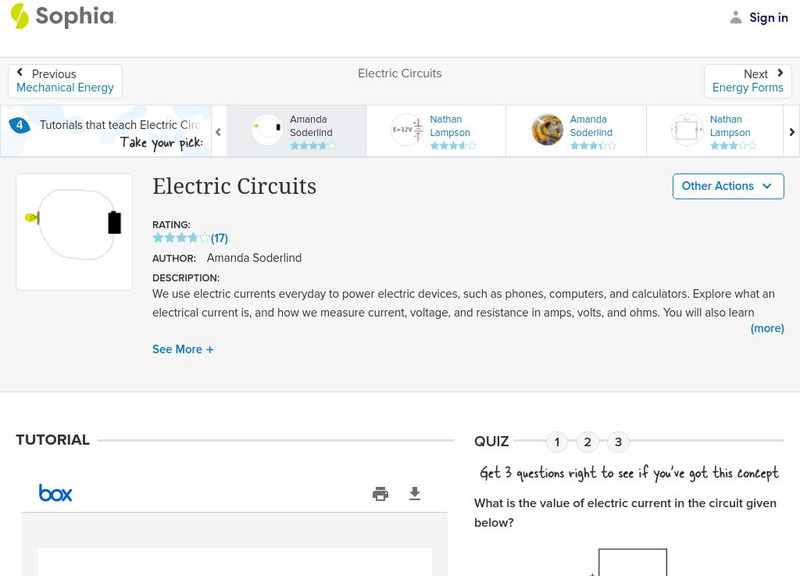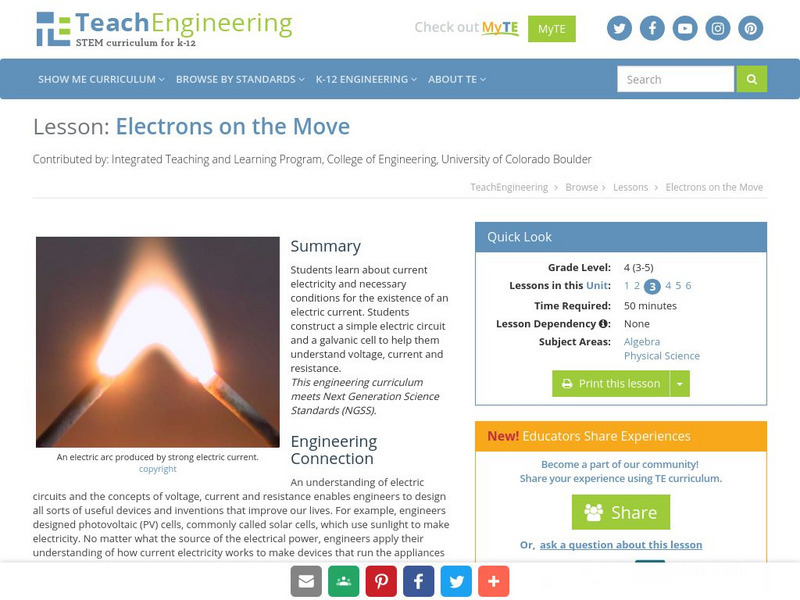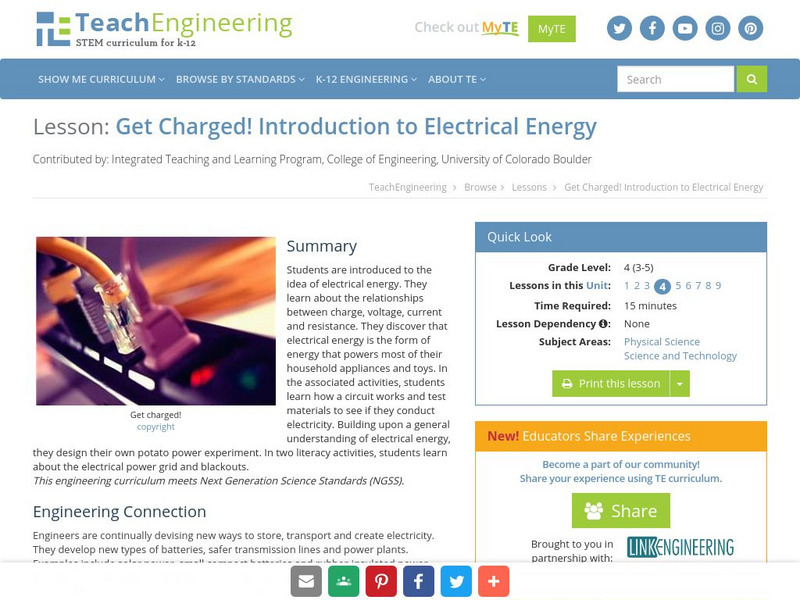Hi, what do you want to do?
Ducksters
Ducksters: Physics for Kids: Electricity Glossary and Terms
Kids learn about electricity glossary and terms in the science of physics. Words and definitions you need to know such as current, voltage, resistance, and more.
TeachEngineering
Teach Engineering: Pointing at Maximum Power for Pv
Student teams measure voltage and current in order to determine the power output of a photovoltaic (PV) panel. They vary the resistance in a simple circuit connected to the panel to demonstrate the effects on voltage, current, and power...
University of Colorado
University of Colorado: Ph Et Interactive Simulations: Ohm's Law
An interactive simulation that teaches about Ohm's Law, circuits, and current by observing how adjusting the voltage and resistance changes current according to Ohm's Law. This simulation can either be downloaded or played online and...
University of Colorado
University of Colorado: Ph Et Interactive Simulations: Battery Resistor Circuit
Look inside a resistor to see how it works. Increase the battery voltage to make more electrons flow through the resistor. Increase the resistance to block the flow of electrons. Watch the current and resistor temperature change. Java...
Georgia Department of Education
Ga Virtual Learning: Ap Physics 1: Electric Circuits
In this unit students discover the meaning and some applications of electric potential, commonly known as voltage, and how it powers some simple circuits.
Georgia State University
Georgia State University: Hyper Physics: Resistor Combinations
At this site from Georgia State University parallel and series connections of resistors are explained and illustrated. Equations for computing the overal voltage, current, and resistance of such circuits are given and explained.
Other
Univ.of Delaware: Real Batteries and Battery Testers
A discussion of various principles related to voltage. The operation of battery testers and voltmeters are explained. The importance of the internal resistance of a power source is discussed.
Physics Aviary
Physics Aviary: Series Circuit Lab
This lab is designed to have students investigate the relationships between voltage, resistance and current in a series circuit with up to three passive components. The batteries in this simulation can be varied from ideal batteries to...
Khan Academy
Khan Academy: Electric Potential Difference and Ohm's Law Review
Review the key terms, equations, and skills related to Ohm's law, including how electric potential difference, current, and resistance are related.
Science Struck
Science Struck: A Comprehensive List of All the Physics Formulas
Provides a long list of physics formulas for easy reference.
Other
Easyphysics: Chapter 13 Current Electricity
Learners investigate current electricity. Some topics examined are voltage law, Ohm?s law, and electric resistance. The resource includes example problems with solutions and a chapter quiz.
CK-12 Foundation
Ck 12: Physics: Electrical Systems Study Guide
A study guide covering electrical systems.
Science and Mathematics Initiative for Learning Enhancement (SMILE)
Smile: Electron Current Flow
A teacher lesson plan which could be easily converted into an idea for a student project or presentation. This page describes an activity in which the water-electricity analogy is used to investigate the relationship between current,...
Sophia Learning
Sophia: Electric Circuits: Lesson 3
This lesson will explain how to calculate voltage, current, and resistance in simple electric circuits. It is 3 of 4 in the series titled "Electric Circuits."
TeachEngineering
Teach Engineering: Electrons on the Move
Students learn about current electricity and necessary conditions for the existence of an electric current. Students construct a simple electric circuit and a galvanic cell to help them understand voltage, current and resistance.
Physics Aviary
Physics Aviary: Capacitor Charging Through a Resistor in Dc Lab
This lab is designed to have students investigate the factors that affect the rate at which a capacitor charges. Students can change the resistance and capacitance in the circuit and monitor the current, voltage and charge on the...
Physics Aviary
Physics Aviary: Rc Circuit Lab
This lab is designed to have students investigate the factors that affect the rate at which a capacitor discharges. Students can change the resistance and capacitance in the circuit and then monitor the discharging of the capacitor....
Concord Consortium
Concord Consortium: Calculating Current in Series Parallel Circuits
Use resistance formulas to determine the total resistances of the series and parallel parts. Then, use Ohm's Law to calculate the voltage drops across and currents through each part.
TeachEngineering
Teach Engineering: Completing the Circuit
In the everyday electrical devices we use - calculators, remote controls and cell phones - a voltage source such as a battery is required to close the circuit and operate the device. In this hands-on activity, students use a battery,...
TeachEngineering
Teach Engineering: Get Charged!
Students are introduced to the idea of electrical energy. They learn about the relationships between charge, voltage, current and resistance. They discover that electrical energy is the form of energy that powers most of their household...
University of Guelph
University of Guelph: Physics Tutorials: Dc Circuits: Resistors in Parallel
Explains and illustrates the meaning of parallel connections. Discusses the voltage-current-resistance relationships for parallel connections of resistors. An example problem on parallel calculations can be accessed from this page.
Physics Aviary
Physics Aviary: Practice Problems: Current in a Wire Problem
Determine the resistance of a wire based on its composition and its physical dimensions. Find the current that would flow through the wire when the wire is connected to a certain voltage.
Physics Aviary
Physics Aviary: Power of a Light Bulb
This lab is will allow students to vary the resistance of a light bulb and the voltage difference across a light bulb. They will be able to see how these two factors affect the current through the light bulb and the power used by the...
CK-12 Foundation
Ck 12: Physics Simulation: Electric Analogies
[Free Registration/Login Required] Explore a different way of thinking about electricity as a way to become familiar with the concept of potential, current, and resistance using this interactive simulation. A PDF worksheet and a video...








